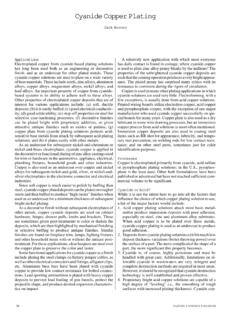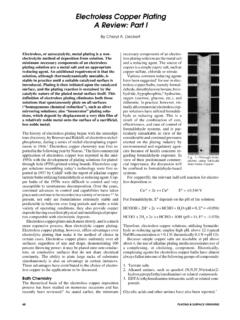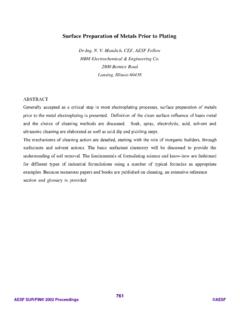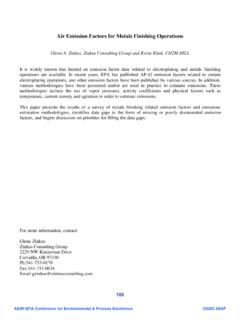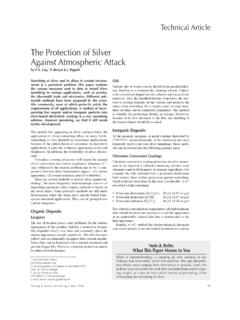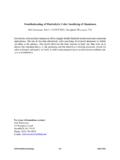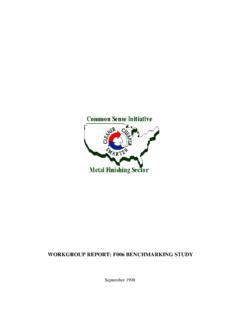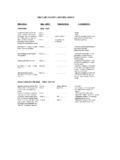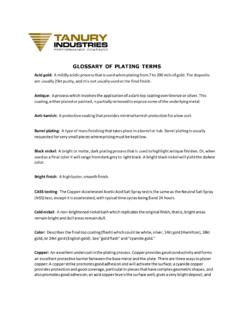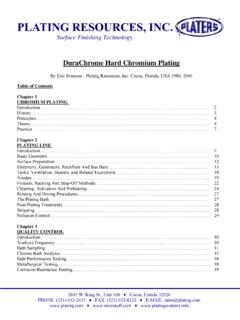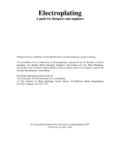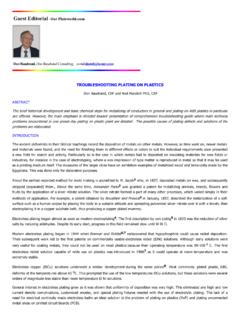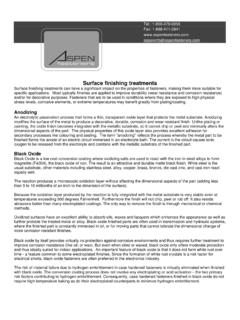Transcription of A Look Back in Plating & Surface Finishing - nmfrc.org
1 34 Plating & Surface Finishing April 2006A Look back in Plating & Surface FinishingThe Story of nickel Plating Part Iby George Dubpernell[Reissued from Plating , 46 (6), 599 (1959)](Recompiled by Lindsay)It is not commonly realized that nickel Plating was discov-ered at Harvard University, about [150] years ago. It is also not appreciated that working out the fi rst commercial pro-cess required ten years of intermittent effort on the part of Isaac Adams Jr., and came as the climax to a long period of struggle and disappointment, after innumerable tests and failures, tragedies and minor Isaac Adams Jr. was born in Boston on February 20, 1836. His mother died a few years later, and he attended boarding schools during much of his adolescence. His father invented the Adams Printing Press a few years before the birth of Isaac Jr., and the manufacture and sale of these fi rst successful power printing presses soon made the family wealthy.
2 Young Isaac was a good student, and his father intended that he should become a doctor. After his graduation from Bowdoin College in Brunswick, Maine, in 1858, he attended the Harvard Medical School where he received his MD degree in 1862. During this period he studied under Josiah Parsons Cooke, professor of mineralogy and chemistry, and during the years 1858 to 1860 he investigated the electrolytic possibilities of many nickel and cobalt salts, and made some electrotypes of these metals about to in. thick ( cm 76 to 127 m thick).2 Some samples made in Among the major metals electroplated in commerce is nickel . From decorative bright fi nishes to today s nanotechnology and MEMS applications, nickel is there. With all of the advanced technology involving nickel Plating in our industry, it is somewhat surpris-ing to learn that nickel Plating has been going on for nearly 150 years.
3 When the AESF (then the AES) cel-ebrated the 50th anniversary of its founding in 1959, the June issue of Plating that year featured a series of articles relating the development of the important plated metals of the mid-20th century. The following article, written by Dr. George Dubpernell, one of the industry pioneers, relates the story of nickel Plating , from its very inception to the 1950s. This fi rst of two parts deals with the very early developments up to the point where the essentials of today s nickel baths were being understood. The reader will fi nd the personal details to be as interesting as the technical were given to Professor Cooke, who placed them in his Upon graduating from Harvard Medical School in 1862, young Isaac went to Paris to continue his studies at the cole de M dicine until the fall of 1864. During this period he studied mostly chemistry , and became profi cient in glass blowing,3 in addition to advanced medical studies.
4 He was also said to have studied under Professor Bunsen in When he returned to the United States in the Fall of 1864, Dr. Adams immediately set up for the practice of medicine at 763 Federal Street, Boston, and lived with his brother Aquila at 43 Chester Square. He apparently failed to build up a good medical practice for one reason or another, perhaps because of his other activities. He estab-lished a laboratory in South Boston for work in chemistry and physics, and from 1865 to 1868 he put his knowledge of glass blowing to practical use by making a large number of Geissler tubes of various sizes and designs, which he sold to Richie of Boston, Chester Bros. of New York City, and Professor Cooke of Harvard At this time he also made a number of vacuum tubes, carbon burner incandescent lamps, more than ten years before Edison. His electric light was essentially identical to Edison s with the exception that he did not develop a high voltage carbon fi lament, but instead used a thin slip of carbon lighted by a low voltage.
5 Not visualizing any cheap source of electric power, he decided not to attempt the electric lighting business. Dr. Adams became engaged to his cousin, Elizabeth Agry Adams, of Norridgewock, Maine, in the latter part of 1864, but she was the ward of his father s brother and business partner, Seth Adams. Uncle Seth was violently opposed to the marriage, and wrote to Elizabeth on February 23, 1865: He is now about twenty-nine years of age and up to this time his record of life is entirely what it ought not to be. He has never earned one cent towards his support and he is in no business that he manages in such a way that gives any evidence that he is likely to. Elizabeth became ill during 1865, and died at Uncle Seth s house in Newton, Mass., August 1, 1866. This must have been a great shock and tragedy to Dr. Adams, and perhaps infl uenced his decision a year or two later to give up the practice of look back 406 343/23/06, 11:53:35 AMPlating & Surface Finishing April 2006 35 Toward the end of 1865, Dr.
6 Adams was approached by Joseph Smith of Boston, a dealer in gas fi xtures, and asked to furnish a substitute for the lava gas-tip. He worked on it for several months, when it occurred to him that a nickel -plated iron tip might serve. Mr. Smith gave him some fi nancial backing to set up about a 20-gal nickel solution, and perhaps also to fi le a patent application. In Dr. Adams own words,1 I commenced nickel - Plating gas tips, I think, in the spring of 1866, but was not particularly successful, although I used, or sup-posed I used, a Plating solution similar in its composition to the one I had used in 1860. I attempted, at that time, with the same solution, to produce an electrotype of nickel similar to the one I had given to Professor Cooke, and failed. The nature of the deposit which I produced was probably not such as to reassure Mr. Smith, or to give him a favorable impression as to the practicability of the process.
7 However that may be, as far as he was concerned, he allowed the thing to drop there. The patent was issued to me soon after I undertook, at that time, to nickel -plate a lot of corset clasps and a patent fi nger guard, but the nickel deposit which I produced was not suited in quality to the purpose, and I was compelled to abandon its application to those articles. I afterwards silver-plated the fi nger guards to the number of about fi fty thousand. This failure to produce what I had already produced six years before, namely, a reguline deposit of nickel , led me to experiment further, to deter-mine the reasons why I succeeded in the one case and failed in the other. In experimenting with the commercial nickel which was to be had in the market of that day, I found that certain substances existing there had to be removed, or their effect in some way neu-tralized. The information obtainable from the books on this subject was exceedingly meager, and I found that I had to commence at the bottom and to determine experimentally the effects produced upon the nickel deposit due to the presence of the substances alluded to above; these were notably zinc, arsenic, copper and iron.
8 This was not all. I found that the presence of the salts of the fi xed alkalis and alkaline earths in certain solutions would have to be excluded or their decomposition prevented, as otherwise, owing to the facility with which such salts are decomposed, secondary products, non-metallic, would make their appearance upon the cathode and injure or ruin the deposit. Further than this I found that the presence of any free acid produced an evolution of hydrogen, lessening the quantity of metal on the cathode, and that the presence of free ammonia, or more properly speaking, an alkaline state of the solution, tended to hinder or prevent the dissolving of the anode. It was only when I had fully completed these experiments that I considered I had such knowledge of the properties of the solution as to enable me to suc-cessfully nickel -plate as a business, or to impart such knowledge as would enable another person to produce a successful deposit.
9 The experiments and discoveries to which I have just referred were completed in the winter of 1867-8. Dr. Adams goes on to describe his work on the production of cast nickel anodes from 1859 to 1868, including the effect of carbon and silica to make the nickel easier to melt, and concludes: .. I found that the addition of a certain amount of iron (to the anodes) would practically prevent the deposition of copper and arsenic. The experiments, methods and directions, both as to solutions and anodes, were completed in the winter of 1867-8 - they were per-fected and reduced to practice at that time. Isaac Adams, Bowdoin, 1858Dr. Isaac Adams, Isaac Adams, record of an early experiment from Dr. Adams notebook No. 1 [tran-scribed by G. Dubpernell Ed.]: July 26, 1866 Made a two-gallon solution of double sulfate of nickel and ammonia for my gas tip glass vat by battery process from nickel containing copper.
10 Acidulated with SO3HO passed. through solution, fi ltered, boiled and neutralized with to 1 gall. & tried with 3 Smee sSp. Gr. about (bad as before) a look back 406 353/23/06, 11:53:37 AM36 Plating & Surface Finishing April 2006 The patent on nickel Plating gas tips was fi led July 16, 1866, and issued on August 21, Dr. Adams stated that he plated more than 100 gross of the iron tips, but the business failed to grow because the lava tips were more profi table. In the early part of 1867, Dr. Adams went to Europe with his brother Aquila and Thatcher. One purpose of the trip was to consider the commercial possibilities of incandescent lamps with A. Gaiffe, an instrument maker in Paris who later became his French backer for the sale of nickel The next effort to commercialize nickel Plating was made by William H.
